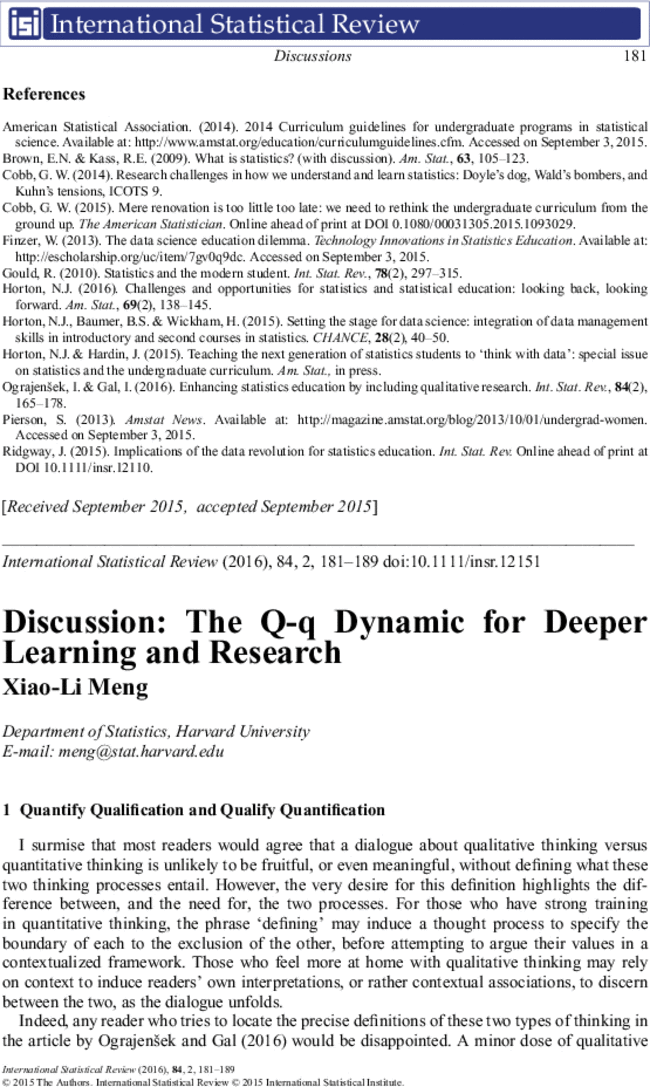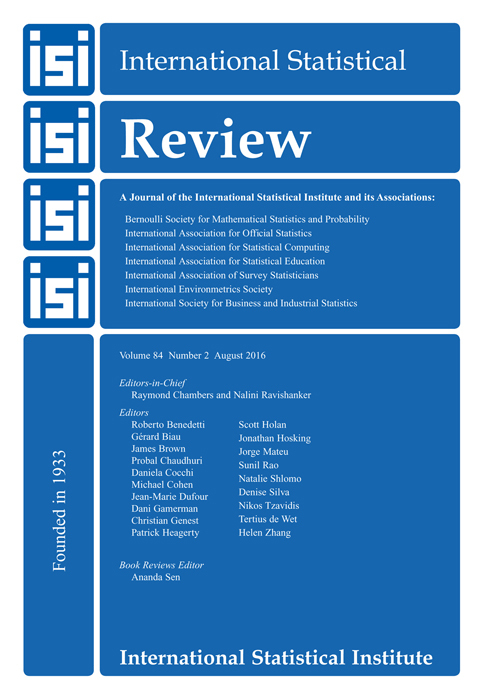Discussion on Enhancing Statistics Education by Including Qualitative Research
Discussion: The Q-q Dynamic for Deeper Learning and Research
Xiao-Li Meng,
Xiao-Li Meng,

References
- Blitzstein J. & Meng X. -L. (2010). Nano-project qualifying exam process: an intensified dialogue between students and faculty. Am. Stat., 64, 282–290.
- Blocker A. W. & Meng X. -L. (2013). The potential and perils of preprocessing: building new foundations. Bernoulli, 19, 1176–1211.
- Duan N., Kravitz R. L. & Schmid C. H. (2013). Single-patient (n-of-1) trials: a pragmatic clinical decision methodology for patient-centered comparative effectiveness research. J. Clin. Epidemiol., 66(8 Suppl), S21–S28.
- Green C. A., Duan N., Gibbons R. D., Hoagwood K. E., Palinkas L. A. & Wisdom J. P. (2015). Approaches to mixed methods dissemination and implementation research: methods, strengths, caveats, and opportunities. Adm. Policy Ment. Health, 42(5), 508–523. Available at http://www.ncbi.nlm.nih.gov/pubmed/24722814. Accessed 11 October 2015.
- Imbens G. & Rubin D. B. (2014). Causal Inference for Statistical, Social, and Biomedical Studies: An Introduction. New York: Cambridge University Press.
- Liu K. & Meng X. -L. (2014). A fruitful resolution to Simpson's paradox via multi-resolution inference. Am. Stat., 68, 17–29.
- R. L. Kravitz, N. Duan, eds, and the DEcIDE Methods Center N-of-1 Guidance Panel, (Duan N., Eslick I., Gabler N. B., Kaplan H. C., Kravitz R. L., Larson E. B., Pace W. D., Schmid C. H., Sim I. & Vohra S.) (2014). Design and Implementation of N-of-1 Trials: A User's Guide. AHRQ Publication No. 13(14)-EHC122-EF. Rockville, MD: Agency for Healthcare Research and Quality. Available at www.effectivehealthcare.ahrq.gov/ehc/products/534/1844/n-1-trials-report-130213.pdf. Accessed 11 October 2015.
- Meng X. -L. (1994). Multiple-imputation inferences with uncongenial sources of input (with discussion). Stat. Sci., 9, 538–558.
- Meng X. -L. (2009). Automated bias-variance trade-off: intuitive inadmissibility or inadmissible intuition? In Frontiers of Statistical Decision Making and Bayesian Analysis, Ed. M. C. Chen et al., pp. 95–112. New York: Springer.
- Meng X. -L. (2014). A trio of inference problems that could win you a Nobel prize in statistics (if you help fund it). In Past, Present, and Future of Statistical Science, Ed. X. Lin et al., pp. 536–562. Boca Raton: CPC Press. Available at http://www.stat.harvard.edu/Faculty_Content/meng/COPSS_50.pdf.
- Meng X. -L. (2016). Discussion of “Perils and potentials of self-selected entry to epidemiological studies and surveys” by Keiding and Louis. J. R. Stat. Soc., Series A, to appear.
- Meng X. -L. & Xie X. (2014). I got more data, my model is more refined, but my estimator is getting worse! Am I just dumb?. Economet. Rev., 33, 218–250.
- Ograjenšek I. & Gal I. (2016). Enhancing statistics education by including qualitative research. Int. Stat. Rev., 84(2), 165–178.
- Rubin D. B. (1987). Multiple Imputation for Nonresponse in Surveys. New York: John Wiley & Sons.
10.1002/9780470316696 Google Scholar
- Xie X. & Meng X. -L. (2016). Dissecting multiple imputation from a multiphase inference perspective: What happens when God's, Imputer's and Analyst's models are uncongenial? (With discussions). Stat. Sinica, to appear.




